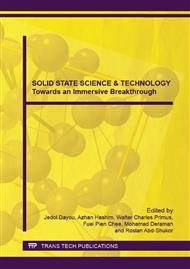[1]
Xiangdong Chen, Kou-Chen Liu, Qiqing Christine Ouyang, Sankaran Kartik Jayanaran, Sanjay Kumar Banerjee, Hole and Electron Mobility Enhancement in Strained SiGe Vertical MOSFETs, IEEE Trans Electron Dev, vol 48(9), 2001, p.1975-(1980).
DOI: 10.1109/16.944185
Google Scholar
[2]
Chan Bun Seng, Mohd Zuhir H., Ismail Saad, Low Power High Performances Analysis of Impact Ionization MOSFET (IMOS) Device, Seminar on Science & Technology 2012, pp.71-77.
Google Scholar
[3]
International Roadmap Committee. The International Technology Roadmap for Semiconductors. <public. itrs. net>.
Google Scholar
[4]
Khakifirooz A, Antoniadis DA, MOSFET Performance Scaling – Part I: Historical Trends., IEEE Trans Electron Dev, vol 55, 2008, p.1391 – 1400.
DOI: 10.1109/ted.2008.921017
Google Scholar
[5]
Khakifirooz A, Antoniadis DA, MOSFET Performance Scaling – Part II: Future Directions, IEEE Trans Electron Dev, vol 55, 2008, p.1401 – 1408.
DOI: 10.1109/ted.2008.921026
Google Scholar
[6]
Gopalakrishnan K, Griffin PB, Plummer J, I-MOS: a novel semiconductor device with a subthreshold slope lower than kT/q, International Electron Device Meeting, IEDM, 2002, p.289 – 292.
DOI: 10.1109/iedm.2002.1175835
Google Scholar
[7]
Gopalakrishnan K, Griffin PB, Plummer JD, Impact Ionization MOS (I-MOS) – Part I: Device and Circuit Simulations, IEEE Trans Electron Dev, vol 52(1), 2005, 69 – 76.
DOI: 10.1109/ted.2004.841344
Google Scholar
[8]
Gopalakrishnan K, Woo R, Jungemann C, Griffin PB, Plummer JD, Impact Ionization MOS (I-MOS) – Part II: Experimental Results, IEEE Trans Electron Dev, Vol 52(1), 2005, p.77 – 84.
DOI: 10.1109/ted.2004.841345
Google Scholar
[9]
Choi WY, Song JY, Lee JD, Park YJ, Park B-G, 100n-m n-/p- channel IMOS using a novel self-aligned structure., IEEE Trans Electron Dev, vol 26(4), 2005, p.261 – 263.
DOI: 10.1109/led.2005.844695
Google Scholar
[10]
Choi WY, Song JY, Lee JD, Park YJ, Park B-G, 70-nm Impact Ionization Metal-Oxide-Semiconductor (I-MOS) devices Integrated with Tunneling Field Effect Transistors (TFETs)., International Electron Device Meeting, IEDM, 2005, p.955 – 958.
DOI: 10.1109/iedm.2005.1609519
Google Scholar
[11]
Choi WY, Effect of Device Parameters on the Breakdown voltage of Impact Ionization metal – Oxide – Semiconductor devices., Jpn J Appl Phys, vol 48, (2009).
DOI: 10.1143/jjap.48.040203
Google Scholar
[12]
Ismail Saad, Divya Pogaku, Abu Bakar AR, Mohd Zuhir H, N. Bolong, Khairul A. M, Bablu Ghosh, Razali Ismail, U. Hashim, Enhanced Performance Analysis of Vertical Strained SiGe Impact Ionization MOSFET (VESIMOS), IEEE Semiconductor Electronics, ICSE2012, 2012, p.177.
DOI: 10.1109/smelec.2012.6417118
Google Scholar
[13]
Thanh Viet Dinh, Rainer Kraus, Christoph Jungemann, Investigation of the Performance of Strained – SiGe Vertical IMOS-Transistor, IEEE, (2009).
DOI: 10.1109/essderc.2009.5331537
Google Scholar
[14]
Thanh Viet Dinh, Christoph Jungemann, Impaact Ionization Rates for Strained Si and SiGe, Solid State Electronics, vol 53, 2009, p.1318 – 1324.
DOI: 10.1016/j.sse.2009.09.013
Google Scholar
[15]
K.S.K. Kwa, S. Chattopadhyay, S.H. Olsen, L.S. Driscoll and A.G. O' Neill, Optimisation of Channel Thickness in Strained Si/SiGe MOSFETs, IEEE, 2003, p.501 – 504.
DOI: 10.1109/essderc.2003.1256923
Google Scholar
[16]
K. Rim, L. Shi, K. Chan, J. Ott, J. Chu, D. Boyd, K. Jenkins, D. Lacey, P. M Mooney, M. Cobb, N. Klymko, F. Jamin, S. Koester, B.H. Lee, M. Gribelyuk, T. Kanarsky, Strained Si for Sub – 100 nm MOSFET, Jyhoriba.
DOI: 10.1109/vlsit.2002.1015406
Google Scholar
[17]
Hakkee Jung, The Analysis of Breakdown Voltage for the Double-Gate MOSFET using the Gaussian Doping Distribution, Journal of Information and Communication Convergence Engineering, JICCE, Vol 10(2), 2012, p.200 – 204.
DOI: 10.6109/jicce.2012.10.2.200
Google Scholar
[18]
Atlas and Athena User Manual Device and Process Simulation Software, Silvaco International, (2005).
Google Scholar
[19]
Abelein U, Assmuth A, Iskra P, Schindler M, Sulima T, Eisele I, Doping Profile Dependence of the Vertical Impact Ionization MOSFETs (IMOS) Performance, Solid State Electronics, Vol 51, 2007, PP. 1405 – 1411.
DOI: 10.1016/j.sse.2007.06.017
Google Scholar
[20]
Scheinert S., Paasch G, Kittler M., Nuernbergk D., Mau H., Schwiers F., Requirements and Restrictions in Optimizing Homogenous and Planar Doped Barrier Vertical MOSFETs, International Caracas Conference on Devices, Circuits and Systems, ICCDCS, (1998).
DOI: 10.1109/iccdcs.1998.705805
Google Scholar
[21]
Minjoo L. Lee, Eugene A. Fitzgerald, Optimized Strained Si/ Strained Ge Dual Channel Heterostructures for High Mobility P- and N- MOSFETs, International Electron Device Meeting, IEDM, 2003, p.429 – 432.
DOI: 10.1109/iedm.2003.1269314
Google Scholar
[22]
Selberherr S. m, Analysis and Simulation of Semiconductor Devices, Springer – Verlag, Wien-New York, (1984).
Google Scholar
[23]
Tarun Vir Singh, M. Jagadesh Kumar, Effect of the Ge Mole Fraction on the Formation of a Conduction Path in Cylindrical Strained Silicon on SiGe MOSFETs, Superlattices and Microstructures, Vol 44, 2008, p.79 – 85.
DOI: 10.1016/j.spmi.2008.02.007
Google Scholar
[24]
Zoolfakar A. S and Ahmad A. Holes Mobility Enhancement Using Strained Silicon, SiGe Technology, International Colloquium on Signal Processing & Its Applications (CSPA), IEEE, 2009, p.346 – 349.
DOI: 10.1109/cspa.2009.5069248
Google Scholar
[25]
Jongwan Jung, Shaofeng Yu, Minjoo L. Lee, Judy L. Hoyt, Eugene A. Fitzgerald, Dimitri A. Antoniadis, Mobility Enhancement in Dual Channel P-MOSFETs, IEEE Trans Electron Dev, Vol 51 (9), 2004, p.1424 – 1431.
DOI: 10.1109/ted.2004.833588
Google Scholar


